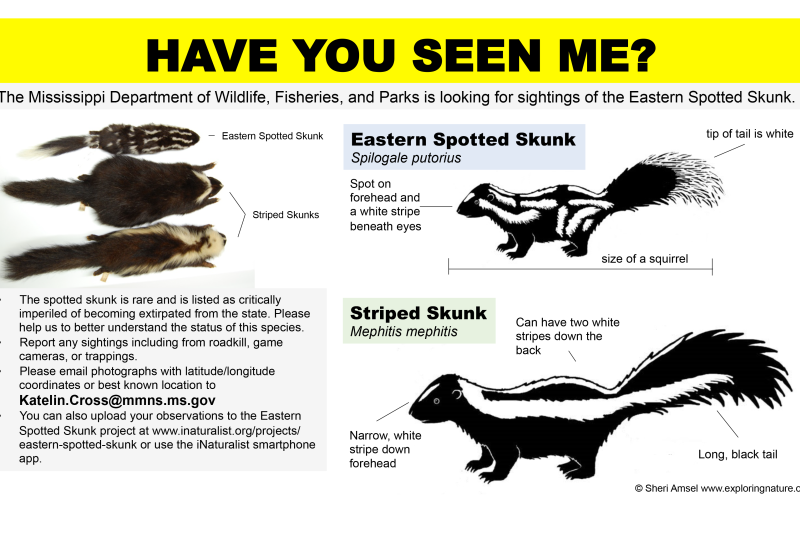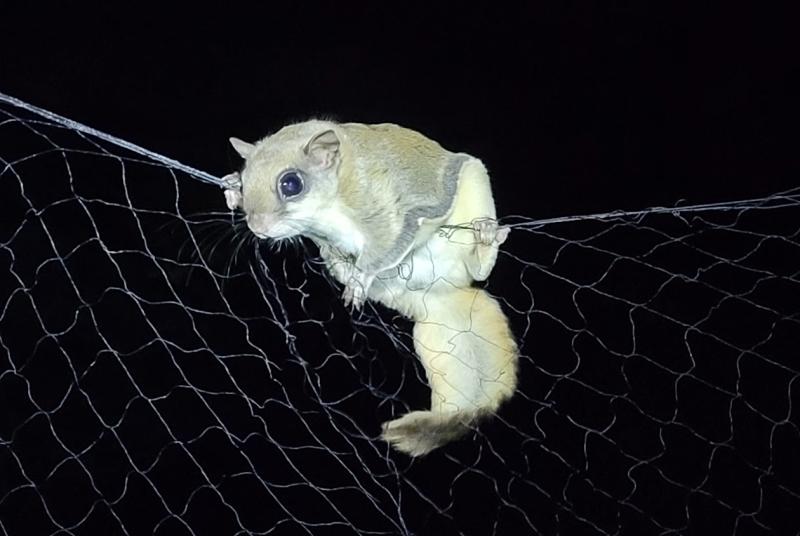
MMNS MAMMALOGY RESEARCH
Email: Katelin.Cross@mmns.ms.gov
Research surveys conducted by museum staff are focused on monitoring populations of species listed in Mississippi’s State Wildlife Action Plan. Current research and monitoring efforts include:
- Bat Conservation and White-nose Syndrome monitoring
- Distribution of Eastern Spotted Skunk (Spilogale putorius) and Long-tailed Weasel (Neogale frenata)
- Small mammal surveys for Oldfield Mouse (Peromyscus polionotus) and Meadow Jumping Mouse (Zapus hudsonius)
Bat Conservation and White Nose-Syndrome Monitoring
There are over 1,400 known bat species that occur worldwide. Bats make up the second largest order of mammals, second only to rodents. All bats species in Mississippi are insectivorous, meaning they consume insects.
Fourteen species of bats have been documented in Mississippi, three of which are federally listed. The Gray Bat (Myotis grisescens), Indiana Bat (Myotis sodalis), and Northern Long-eared Bat (Myotis septentrionalis) are listed as endangered. The Tricolored bat (Perimyotis subflavus) is currently proposed to be listed as endangered. There are currently 9 bat species considered species of conservation need in Mississippi.
Threats to bats include White-nose Syndrome, habitat destruction, and poor public image. White-nose syndrome has caused the death of over 5.7 million bats in North America, and has devastated Northern Long-eared Bat populations by a decline of 99%. Bats are slow to recover from impacts since majority of species have one pup per year.
Most bat species rely heavily on forested habitats to provide both roosting and foraging sites. Some bats have adapted to man-made structures such as bat houses, bridges, and transportation structures for roost sites.
Research is necessary to understand where different species of bats occur and at what abundance. Outreach programs to educate the public are necessary for people to understand facts about bats, such as bats are not blind and less than 0.5% of bats have rabies.
Bats play a very important ecological role through regulation of the insect population, maintaining the health of natural ecosystems, and are also beneficial to the economy.
The Mississippi Museum of Natural Science contributes to the conservation of bats through research and education. Bat research and conservation projects include:
- Surveying hibernacula such as caves, culverts, and bridges and testing for the fungus, Pseudogymnoascus destructans (Pd), that is responsible for white-nose syndrome. Since the start of the surveillance program in 2012, twelve counties have tested positive for the fungus. Our first case of white-nose syndrome was documented in a culvert in Montgomery County. Not only was it the first case for Mississippi, but this was the first documentation of the disease in a culvert.
- Conducting mist net, harp net, and acoustic surveys throughout the state to determine species diversity, relative abundance, and distribution of Mississippi bats.
- Pit-tagging and using telemetry to monitor roost selection and movement behaviors of bats.
- Surveying maternity colonies in caves, transportation structures, and abandoned buildings to understand life history of our bat species.
- Educating the public with outreach programs for all ages to dispel common myths about bats, provide information on the importance of bats, and how to protect them.
Distribution of Eastern Spotted Skunk
Eastern Spotted Skunks (Spilogale putorius) have experienced a decline range-wide since the mid-1900s that is possibly due to modification to their habitat. Since 2000, Eastern Spotted Skunks have been confirmed in five counties in Mississippi.
Current surveys are being conducted utilizing trail cameras on public lands as well as Adapted-Hunt Drift Fence Technique (AHDriFT) for year long surveys.
If you have seen an Eastern Spotted Skunk, please report the siting and location to Katelin Cross.
Small Mammal Surveys for Oldfield Mouse and Meadow Jumping Mouse
Oldfield mouse (Peromyscus polionotus) and Meadow Jumping Mouse (Zapus hudsonius) have a limited distribution in the state and occur in low numbers. Currently, there are only two confirmed records of the Meadow Jumping Mouse in Mississippi, with one specimen residing at the Mississippi Museum of Natural Science Mammalogy collection.
Northern subspecies of Oldfield mouse is thought to be extirpated from the state. Southern populations have greatly diminished in recent years.
Ongoing research is being conducted to better understand where these species occur in the state and if population numbers are declining.
More Information
- Mississippi Bat Working Group
- Southeastern Bat Diversity Network
- Bat Conservation International
- White-Nose Syndrome Response Team


